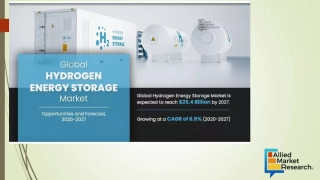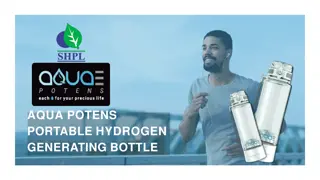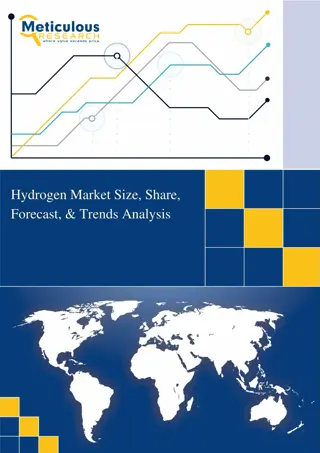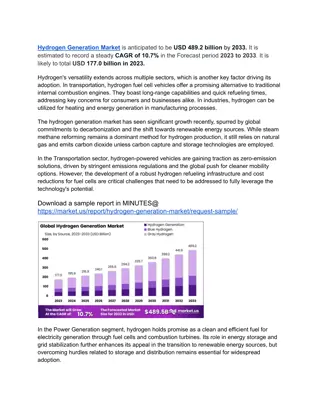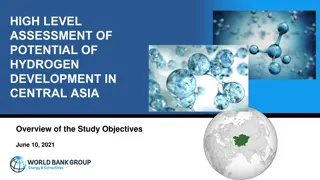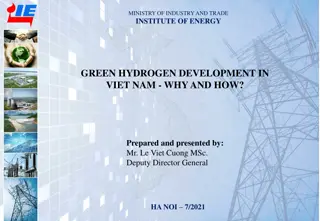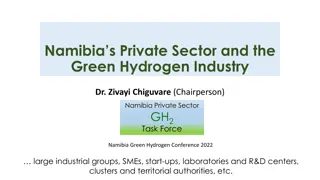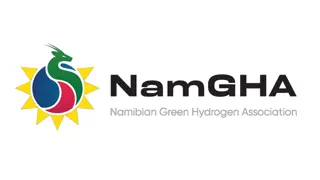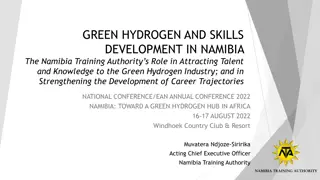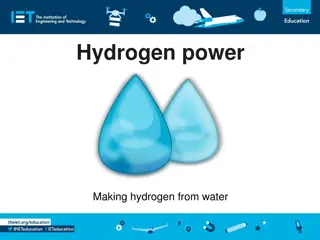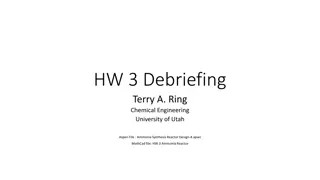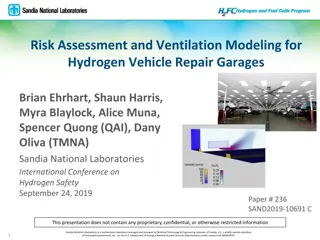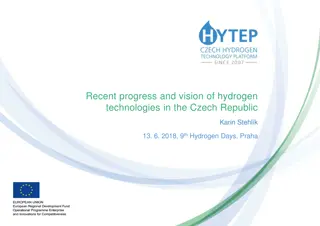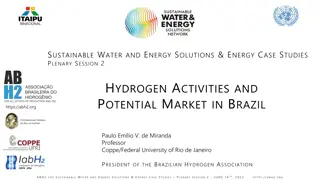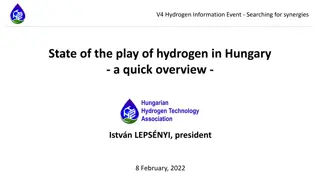Green Hydrogen (Ammonia) Outlook: Europe-Egypt Case Study
This study explores the green hydrogen (ammonia) outlook in Europe and Egypt, focusing on opportunities, challenges, and the techno-economic, geopolitical, and regulatory factors. It discusses the surge in ammonia prices due to the Russian-Ukrainian conflict, the expected ammonia production capacity, technological aspects, solar power potential, and legal considerations for different types of ammonia production. The importance of certification schemes for distinguishing between fossil-based, fossil-based with CCS, and renewable ammonia is highlighted.
Download Presentation

Please find below an Image/Link to download the presentation.
The content on the website is provided AS IS for your information and personal use only. It may not be sold, licensed, or shared on other websites without obtaining consent from the author.If you encounter any issues during the download, it is possible that the publisher has removed the file from their server.
You are allowed to download the files provided on this website for personal or commercial use, subject to the condition that they are used lawfully. All files are the property of their respective owners.
The content on the website is provided AS IS for your information and personal use only. It may not be sold, licensed, or shared on other websites without obtaining consent from the author.
E N D
Presentation Transcript
Session 20, 559 Green Hydrogen (Ammonia) Outlook-Europe Egypt Case Opportunities and Challenges Techno-Economic, Geopolitical, Regulatory Filling the Gaps Study AHMED ABDELHADY, HAYTHEM KAMEL, MONA ELMESSERY, Formation et Sensibilisation de Luxembourg FSL
AMMONIA PRICE TREND Surge peaked in the fertilizers and Ammonia due to Russian Ukrainian Conflict Feedstock prices (Natural Gas)/Distribution and Supply Chain/ Russia, Ukraine, Europe are Major market players Cont. increasing demand for fertilizers, Ammonia and Urea prices met levels that did not reach ever before EGYPS.COM
EXPECTED AMMONIA PRODUCTION CAPACITY Ammonia today is produced from NG (72%), Coal (22%), Heavy Naphtha (4%) Annual emissions of 0.5 (Gt) of CO2 (around 1% of global CO2 emissions, 15-20% of the chemical sector s CO2 emissions) EGYPS.COM
TECHNOLOGY/COLOR CODES EGYPS.COM
ECONOMICAL In Solar Power No Country in Europe has similar potential The bottom line: the electricity sector could save much by constructing solar farms, rather than fossil fuel alternatives. LCOE in constructing solar farms in optimum zones is 29.7% lower than investing in combined-gas turbines, and 37% lower than investing in diesel generators. EGYPS.COM
LEGAL Many ammonia plants are integrated hybrids, incorporating more than one color Some colors refer to carbon-free inputs or carbon abatement technologies Colors lack legal definition and do not communicate the greenhouse gas emission intensity of the product, Blue ammonia with a 70% carbon capture rate versus blue ammonia with a 98% carbon capture rate) Robust certification schemes that can calculate and verify the emission intensity of ammonia will be essential, to distinguish between fossil-based ammonia, fossil-based ammonia with CCS, and renewable ammonia. Separate markets will need to develop, supported by certification schemes, contracts for difference and other mechanisms EGYPS.COM
LEGAL The ammonia molecule derived from any source is the same, but the carbon footprint is not. Guarantees of origin are required, indicating the CO2-equivalent footprint of the ammonia from raw material extraction to the use phase, It allows ammonia producers and consumers to reach agreements on the value of low-carbon ammonia. Similar certificates already exist for electricity production. Certificates could in theory be traded separate from the physical ammonia product, for example within a book-and-claim system. The classification of low-carbon ammonia should be straightforward. Inspiration can be obtained from hydrogen production. EGYPS.COM
LEGAL A system uses the term low carbon for hydrogen with a carbon footprint at least 60% lower than for SMR. Comparison of lower-carbon fuels based on energy content rather than on mass basis allows for a level playing field among alternative fuels. Focus should not only be on-site CO2 emissions but on all greenhouse gases as well as other criteria including water use and upstream emissions. Various schemes are being pursued, including methodology development by IPHE (International Partnership for Hydrogen and Fuel Cells in the Economy) and an ammonia certification scheme under development by the Ammonia Energy Association. Depending on the application, different ammonia purity levels may be required. Certification schemes could provide both the CO2-equivalent footprint and the purity grade of the ammonia. EGYPS.COM
BARRIERS/CONCLUSION BARRIERS Capital availability; FDI Macro-Economic Policy; State vs. Private/PPP Investment Regulatory compliance among both sides; Customs; Import regulations for Currency CONCLUSION Technology has to be considered as there are no on-shelf solutions, such as selection between PV and CSP in the case of Electric Power Generation. Trade between renewable energy and green ammonia production from an ROI point of view. Other regulatory and inter-political issues have to be considered for huge potential. EGYPS.COM
AHMED ABDELHADY, HAYTHEM KAMEL, MONA ELMESSERY, Formation et Sensibilisation de Luxembourg-FSL THANK YOU


